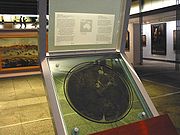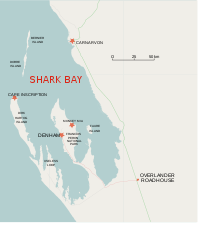
Hartog Plate
Encyclopedia

Dirk Hartog Island
Dirk Hartog Island is an island off the Gascoyne coast of Western Australia, within the Shark Bay World Heritage Area. It is about 80 kilometres long and between 3 and 15 kilometres wide and is Western Australia's largest and most western island. It covers an area of 620 square kilometres and is...
during a period of European exploration
European exploration of Australia
The European exploration of Australia encompasses several waves of seafarers and land explorers. Although Australia is often loosely said to have been discovered by Royal Navy Lieutenant James Cook in 1770, he was merely one of a number of European explorers to have sighted and landed on the...
of the western coast of Australia prior to European settlement there. The first plate, left by Dutch
Netherlands
The Netherlands is a constituent country of the Kingdom of the Netherlands, located mainly in North-West Europe and with several islands in the Caribbean. Mainland Netherlands borders the North Sea to the north and west, Belgium to the south, and Germany to the east, and shares maritime borders...
explorer Dirk Hartog
Dirk Hartog
Dirk Hartog was a 17th century Dutch sailor and explorer. Dirk Hartog's expedition was the third European group to land on Australian soil. He was the first to leave behind an artifact to record his visit, the Hartog plate. His name is sometimes alternatively spelled Dirck Hartog or Dierick...
, is the oldest-known artifact of European exploration in Australia still in existence and is therefore evidence of the first confirmed visit by Europeans.
The subsequent discoveries, comprising three additional visits spanning 200 years, are remarkable considering the extreme isolation of the region.
Dirk Hartog, 1616
Dirk Hartog was the first confirmed European to sight Western Australia, reaching it in his ship, the EendrachtEendracht (1615 ship)
The Eendracht was an early 17th Century Dutch wooden-hulled sailing ship, launched in 1615 in the service of the Dutch East India Company...
. On 26 October 1616, he landed at Cape Inscription on the very northernmost tip of the island. Before departing, Hartog left behind a flattened pewter
Pewter
Pewter is a malleable metal alloy, traditionally 85–99% tin, with the remainder consisting of copper, antimony, bismuth and lead. Copper and antimony act as hardeners while lead is common in the lower grades of pewter, which have a bluish tint. It has a low melting point, around 170–230 °C ,...
dinner plate, nailed to an oak post and placed upright in a fissure on the cliff top.
The plate bears the inscription:
"Ao 1616, den 25sten October, is hier vangecommen het schip de ENDRACHT
van Amsterdam, den Oppercoopmen Gilles Mibais van Luyck; schipper Dirk
Hartog, van Amsterdam, den 27sten, dito t' zeijl gegaen na Bantam, den
Ondercoopman Jan Stoyn, Opperstierman Pieter Dockes, van Bil, Ao 1616."
Translated into English:
On the 25th October, arrived here the ship Endracht of
Amsterdam; the first merchant, Gilles Mibais, of Luyck; Captain Dirk
Hartog; of Amsterdam; the 27th ditto set sail for Bantam; undermerchant
Jan Stoyn, upper steersman, Pieter Dockes, from Bil, Ao, 1616.
Willem de Vlamingh, 1697

Netherlands
The Netherlands is a constituent country of the Kingdom of the Netherlands, located mainly in North-West Europe and with several islands in the Caribbean. Mainland Netherlands borders the North Sea to the north and west, Belgium to the south, and Germany to the east, and shares maritime borders...
sea captain Willem de Vlamingh
Willem de Vlamingh
Willem Hesselsz de Vlamingh was a Dutch sea-captain who explored the central west coast of Australia in the late 17th century.- Vlamingh and the VOC :...
also reached the island and discovered Hartog's pewter plate with the post almost rotted away. He removed it and replaced it with another plate which was attached to a new post. The new post was made of a cypress pine trunk taken from Rottnest Island
Rottnest Island
Rottnest Island is located off the coast of Western Australia, near Fremantle. It is called Wadjemup by the Noongar people, meaning "place across the water". The island is long, and at its widest point with a total land area of . It is classified as an A Class Reserve and is managed by the...
. The original plate was returned to the Netherlands, where it is still kept in the Rijksmuseum Amsterdam. De Vlamingh's replacement plate contains all of the text of Hartog's original plate as well as listing the senior crew of his own voyage. It concludes with:
"1697. Den 4den Februaij is hier vangecommen het schip de GEELVINK van
Amsterdam, den Commandeur schipper, Williem de Vlamingh, van Vlielandt,
Adsistent Joan van Bremen, van Coppenhage; Opperstierman Michiel Blom van
Estight, van Bremen. De Hoecker de NYPTANG, schipper Gerrit Collaert van
Amsterdam; Adsistent Theodorus Heermans van de; d`Opperstierman Gerrit
Gerritz, van Bremen, 't Galjoot t' WESELTJE, Gezaghabber Cornelis de
Vlamingh van Vlielandt; Stierman Coert Gerritz, van Bremen, en van hier
gezeilt met ons vloot den 12do voorts net Zuijtland te ondersoecken en
gedestineert voor Batavia."
Translated into English:
On the 4th of February, 1697, arrived here the ship
GEELVINCK, of Amsterdam; Commandant Wilhelm de Vlamingh, of Welandt;
assistant, Jan van Bremen, of Copenhagen; first pilot, Michiel Bloem van
Estight, of Bremen. The hooker, the NYPTANGH, Captain Gerrit Collaert, of
Amsterdam, Assistant Theodorus Heermans, of the same place; first pilot,
Gerrit Gerritz, of Bremen; then the galliot WESELTJE, Commander Cornelis
de Vlaming, of Vlielandt; Pilot Coert Gerritz, from Bremen. Sailed from
here with our fleet on the 12th, to explore the South Land, and
afterwards bound for Batavia.
Emmanuel Hamelin, 1801
In 1801, the French captain of the Naturaliste Jacques Félix Emmanuel Hamelin, second in command of an expedition led by Nicolas BaudinNicolas Baudin
Nicolas-Thomas Baudin was a French explorer, cartographer, naturalist and hydrographer.Baudin was born a commoner in Saint-Martin-de-Ré on the Île de Ré. At the age of fifteen he joined the merchant navy, and at twenty joined the French East India Company...
in the Geographe entered Shark Bay
Shark Bay
Shark Bay is a World Heritage listed bay in Western Australia. The term may also refer to:* the locality of Shark Bay, now known as Denham* Shark Bay Marine Park* Shark Bay , a shark exhibit at Sea World, Gold Coast, Australia* Shire of Shark Bay...
and sent a party ashore. The party found Vlamingh's plate, even though it was half buried in the sand, as the post had rotted away with the ravages of the weather. When they took the plate to the ship, Hamelin ordered it to be returned, believing its removal would be tantamount to sacrilege. He also had a plate, or similar, of his own prepared and inscribed with details of his voyage and he had both erected at the Vlamingh site. It was then named Cape Inscription.
Louis de Freycinet, 1818
In 1818 in the Uranie, French explorer Louis de FreycinetLouis de Freycinet
Louis Claude de Saulces de Freycinet was a French navigator. He circumnavigated the earth, and was one of the first to produce a comprehensive map of the coastline of Australia.-Biography:...
, who had been an officer in Hamelin's 1801 crew, sent a boat ashore to recover Vlamingh's plate and substituted a lead plate, which has never been found. His wife Rose de Freycinet, who was on board, having stowed away with her husband's assistance, recorded the event in what was in effect a diary of her circumnavigation. After being shipwrecked in the Falkland Islands the plate and other materials from the Uranie voyage were later transferred to another ship and taken to France, where it was presented to the Académie française
Académie française
L'Académie française , also called the French Academy, is the pre-eminent French learned body on matters pertaining to the French language. The Académie was officially established in 1635 by Cardinal Richelieu, the chief minister to King Louis XIII. Suppressed in 1793 during the French Revolution,...
in Paris.
After being lost for more than a century, the Vlamingh plate was rediscovered in 1940 on the bottom shelf of a small room, mixed up with old copper engraving plates. In recognition of Australian losses in the defence of France during the two world wars, the plate was eventually returned to Australia in 1947 and is currently housed in the Western Australian Maritime Museum
Western Australian Museum
The Western Australian Museum is the state museum for Western Australia.The Western Australian Museum has seven main sites: two in Perth within the Perth Cultural Centre, two in Fremantle , and one each in Albany, Geraldton, and Kalgoorlie-Boulder...
in Fremantle, Western Australia
Fremantle, Western Australia
Fremantle is a city in Western Australia, located at the mouth of the Swan River. Fremantle Harbour serves as the port of Perth, the state capital. Fremantle was the first area settled by the Swan River colonists in 1829...
.
Cape Inscription Lighthouse plaques
Marking the location in 1938, the Commonwealth government commemorated Dirk Hartog's landing with a brass plaque.Just short of 60 years later, on 12 February 1997, the then premier of Western Australia Richard Court
Richard Court
Richard Fairfax Court AC , was a Western Australian politician, representing the seat of Nedlands in the Western Australian Legislative Assembly for the Liberal Party of Australia from 1982 to 2001. He served as Premier of Western Australia from 1993 to 2001.Court was born into an old political...
unveiled a bronze plaque to mark the tricentennial of Vlamingh's visit.
The lighthouse and plaques are located at 25°28′55"S 112°58′19"E.

